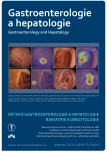Assistance system for real-time polyp detection based on convolutional neural network
Authors:
Kvak D.; Kvaková K.
Authors‘ workplace:
Masarykova univerzita, Brno
Published in:
Gastroent Hepatol 2021; 75(6): 540-543
Category:
doi:
https://doi.org/10.48095/ccgh2021540
Overview
The use of artificial intelligence as an assistive detection method in endoscopy has attracted increasing interest in recent years. Machine learning algorithms promise to improve the efficiency of polyp detection and even optical localization of findings, all with minimal training of the endoscopist. The practical goal of this study is to analyse the CAD software (computer-aided diagnosis) Carebot for colorectal polyp detection using a convolutional neural network. The proposed binary classifier for polyp detection achieves accuracy of up to 98%, specificity of 0.99 and precision of 0.96. At the same time, the need for the availability of large-scale clinical data for the development of artificial--intelligence-based models for the automatic detection of adenomas and benign neoplastic lesions is discussed.
Keywords:
artificial intelligence – polyp detection – convolutional neural network – computer-aided diagnosis – spatial location
Sources
1. WHO. Cancer. 2021 [online]. Available from: https: //www.who.int/news-room/fact-sheets/ detail/cancer.
2. Jrebi NY, Hefty M, Jalouta T et al. High-definition colonoscopy increases adenoma detection rate. Surg Endosc 2017; 31 (1): 78–84. doi: 10.1007/s00464-016-4986-7.
3. Murphy B, Myers E, O’Shea T et al. Correlation between adenoma detection rate and polyp detection rate at endoscopy in a non-screening population. Sci Rep 2020; 10 (1): 2295. doi: 10.1038/s41598-020-58963-y.
4. Wang P, Berzin (tm), Brown JR et al. Real-time automatic detection system increases colonoscopic polyp and adenoma detection rates: a prospective randomised controlled study. Gut 2019; 68 (10): 1813–1819. doi: 10.1136/gutjnl-2018-317 500.
5. Jeong YH, Kim KO, Park CS et al. Risk factors of advanced adenoma in small and diminutive colorectal polyp. J Korean Med Sci 2016; 31 (9): 1426–1430. doi: 10.3346/jkms.2016.31.9.1426.
6. Pogorelov K, Randel KR, Griwodz C et al. KVASIR: a multi-class image dataset for computer aided gastrointestinal disease detection. Taipei Taiwan: ACM 2017. doi: 10.1145/3083187.3083212.
7. Shin Y, Qadir HA, Aabakken L et al. Automatic colon polyp detection using region based deep CNN and post learning approaches. IEEE Access 2018; 6: 40950–40962. doi: 10.1109/ACCESS.2018.2856402.
8. Selvaraju RR, Das A, Vedantam R et al. Grad-CAM: visual explanations from deep networks via gradient-based localization. Int J Computer Vision 2020; 128 (2): 336–359. doi: 10.1007/s11263-019-01228-7.
9. He K, Zhang X, Ren S et al. Deep residual learning for image recognition. 2015 [online]. Available from: http: //arxiv.org/abs/1512.03385.
10. Barua I, Vinsard DG, Jodal HC et al. Artificial intelligence for polyp detection during colonoscopy: a systematic review and meta-analysis. Endoscopy 2021; 53 (3): 277–284. doi: 10.1055/a-1201-7165.
Labels
Paediatric gastroenterology Gastroenterology and hepatology SurgeryArticle was published in
Gastroenterology and Hepatology

2021 Issue 6
Most read in this issue
- Azathioprine in the therapy of paediatric inflammatory bowel disease – part I: treatment indications, dosing and thiopurine-related adverse events
- Diet after bariatric surgery in practice
- Prof. MUDr. Petr Dítě, DrSc., slaví 80 let
- Gluten-related immunogenic peptides in stool as means to monitor compliance with gluten-free diet in children with newly diagnosed coeliac disease
